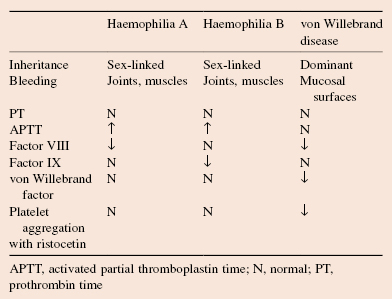Excessive bleeding may occur as a result of an inherited defect of one or other protein involved in coagulation. Inherited deficiency of each of the coagulation factors has been described.
Factor VIII deficiency (haemophilia A)
Factor VIII deficiency (haemophilia A) is the most common inherited coagulation disorder. The factor VIII gene is on the X chromosome so inheritance is sex-linked with the severe disease occurring in males (Fig. 42.1). A wide range of genetic changes of the factor VIII gene including deletions, insertions, point mutations and a common intragene inversion underlie the disease.
Clinical features
- These range from severe spontaneous bleeding, especially into joints (haemarthroses) and muscles, to mild symptoms, depending on the factor VIII level (Fig. 42.2).
- Onset in early childhood (e.g. post-circumcision).
- Increased risk of post-operative or post-traumatic haemorrhage.
- Chronic debilitating joint disease caused by repeated bleeds.
- Pseudotumours as a result of extensive fascial or subperiosteal bleeds.
Laboratory features (Table 42.1)
- Prolonged activated partial thromboplastin time (APTT), normal prothrombin time (PT), normal PFA-100 test. Plasma factor VIII is reduced (<1% of normal in severe cases, 1–5% in moderate cases and 5–40% in mild cases.
- Carriers have factor VIII levels in plasma approximately 50% of normal. If the levels are <40% they may have clinical features of mild haemophilia. DNA analysis is helpful in carrier detection and antenatal diagnosis.
- Von Willebrand factor (vWF) level is normal.







